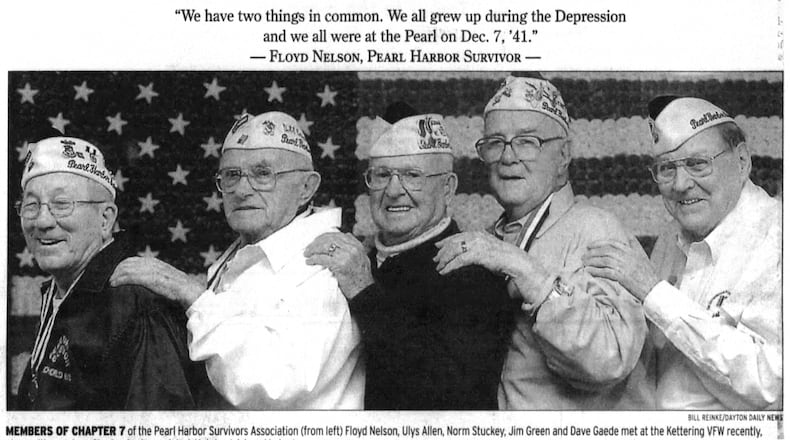Anybody who was within three miles of the coastline of Oahu, Hawaii is considered a Pearl Harbor survivor. Over the years, many articles were written about local Pearl Harbor survivors. To recognize the anniversary of the attack, we went into the archives to share their stories.
Jim Green, Beavercreek
Green was on firefighting duty the morning of the attack. His first job was to put out fires on the two destroyers, the Cassins and the Downes.
“I was stationed at the submarine base at Pearl Harbor,” he said in 1994. “On that particular Sunday morning I had firefighter duty...When the attack came, we got a call from the Navy yard to go over and fight a fire that had started in the dry dock.
“We were then assigned to the 50-caliber machine guns up on the bachelor officers quarters, but it didn’t do much good because we didn’t have any ammunition. The gunnery officer was at home wit his family and there was no way to get into the armory to get the ammunition.”
By the time they could get the armory open, “all of the Japanese planes were gone ... so we never even fired a shot,” he said.
Charles Copley, Butler Twp.
Credit: Dayton Daily News�
Credit: Dayton Daily News�
Copley had an early-morning watch on the day of the attack and saw it happen.
“I had the 0400 to 0800 watch that morning, so I was on the bridge of the destroyer Downes when the first Japanese planes swept down on the harbor,” Copley said in 2004.
“The noise was deafening. The scene was absolutely unbelievable.”
Ulys Allen, Centerville
Allen was aboard the California, one of seven battleships along “Battleship Row” when the attack started.
“I was amidships on the lowest level, 25 below the waterline.” he said in 2004. “My first clue that it wasn’t a drill came when the bulkhead that separated my battle station from the main radio room cracked and water started pouring in. An hour later they ordered us ‘over the side.’ I was a lousy swimmer, but I managed to dog-paddle to shore.”
Reuben Eichman, Springfield
Eichman was aboard the USS Utah during the attack.
“It was a quiet Sunday morning,” he said in 1966. I remember when we heard the first explosion and thought it was a magazine on one of the ship’s guns.
“At the time of the first explosion, I was putting on a baseball uniform. Our ship had a game scheduled that Sunday.
“I went top-side after the first explosion and saw the ship hit by three torpedoes and two bombs. We didn’t know what to do but the ship started listing badly almost at a 45 degree angle.
“I jumped overboard and began swimming for shore which was 300 yards away. I was not aware that anyone was getting hurt until (a man) we called “Smitty” who was swimming in front of me (was killed) by machine gun fire. When I reached shore, the only thing that made me feel safe was running. We didn’t have anything to fire back with and I was just scared.”
Delbert Sharrett, Madison Twp.
Sharrett was about 80 miles from the harbor, aboard the USS Seagull submarine at the time of the attack. They were ordered back immediately to fight fires.
“The Oklahoma was turned upside down, and the Utah was turned upside down,” he said. “The Arizona, she was completely underwater.”
Art Lloyd, Dayton
Lloyd was a photographer in the public information office at Wright Patterson Air Force Base who was at Pearl Harbor on assignment. He was stationed at Hickam Field with the 17th Air Base Group.
Art was getting ready to go to a beach party at the time. Instead, he ended up hauling the injured to hospitals.
At one point, he saw the bombing of a guardhouse.
“They blew it up and about everyone inside was killed,” he said in 1948.
Syd Davis, Yellow Springs
Syd Davis, who was stationed at Hickam Field with the 17th Air Base Group, had his left arm shot off during the attack.
“They (the Japanese) just started shooting,” Davis said in 1948. “I had just returned home from church. I didn’t know what to do, so I took off for the mountains.
“Then I remembered I didn’t have any clothes on so I went back in the barracks and got dressed. The first sergeant took a group of us to a hanger. That’s when they hit us — dropped bombs on both sides of the hanger and strafed us. There were about 15 of us in there and all were either killed or lost and arm or leg.”
“Strafed” is a term that mean attacked repeatedly with bombs or machine-gun fire from low-flying aircraft.
In spite of all that he experienced, Davis considered himself lucky and said, “I have no gripes.”
Owen W. Smith, Springfield
Smith was having breakfast aboard the USS New Orleans.
“All our big guns were under canvas and they took knives and cut the canvas down,” he said in 1966. “What saved us from being hit harder was a large crane at the dock and the Japanese planes couldn’t come in low on us.”
“We couldn’t figure out why we weren’t better prepared. We had been operating under war time conditions for several months — but the attack was a complete surprise. Aboard our ship was a chaplain who watched the magazine ammunition being hauled up by hand from the lower decks. He was the one who coined the phrase, ‘Praise the Lord and pass the ammunition’.”
Allen Hieatt, Springfield
Hieatt was on duty aboard the USS Whitney, a destroyer, that morning.
“It was a beautiful day,” he said in 1966 “I was on motor launch ... I noticed that over towards Fort Island there was black smoke but I thought it was target practice. Even when the planes came over and we could see the Japanese emblem, it was hard to believe — this just couldn’t happen.”
Wayne Martin, Oxford
Credit: Submitted
Credit: Submitted
Martin, a machinist mate on the USS Maryland, was in the bathroom preparing to go ashore when the attack came.
“A shipmate was addressing Christmas cards when he noticed smoke from an air base building and a plane with the rising sun emblem,” he said in 2004.
“He loaded his machine gun and shot down a plane that had just dropped a torpedo into the USS Oklahoma. That may have been the first plane that was shot down.
“The scene topside which I observed in the period I was there will always remain in my memory. Black smoke and flames. Oil was burning in the water and sailors were swimming through the water where the oil was burning on the surface. Several ships burned for days.”
Albert Kemmerling, Middletown
Credit: PAT AUCKERMAN
Credit: PAT AUCKERMAN
Kemmerling had been working at Kancohe Naval Air Station, installing guns on Oahu’s north shore. He said he took cover under the barracks.
“When (the Japanese) started bombing, I was in bed,” he said in 2004. “We had our guns, but we didn’t have our ammunition,”
Christopher Ward, Dayton
Ward was sergeant of the guard at Wheeler Field in central Oahu.
“The first three aircraft I saw looked like Navy SDB dive bombers on a practice field. I was talking to the corporal of the guard, and he said they looked different. I said, ‘You dummy, they’re carrying torpedoes,” he said in 1967.
“Well, they did have torpedoes and they were painted identical to Navy planes, the first three. The others were not. They had Japanese insignia on. I’ll never forget that sight.”
Nicholas Lira, Dayton
Lira was a fireman first class aboard the destroyer Downes.
“At the exact moment of attack I was wrapping Christmas gifts because Monday was the last day out for Christmas gifts,” he said in 1967. “And a guy hollered down the hatch, ‘They’re bombing the hell out of Ford Island’
“And so I went up above. We were in dry dock and couldn’t move. We fired our guns as well as we could. They flooded the dry dock ... we couldn’t float because our front plates were off. We were hit and lost 13 men.”
David Gaede, Kettering
Gaede was standing in line for breakfast at the junior mess hall when the attack began.
“One came in real low, about 200 to 300 feet,” he said in 2001. “I could see the face on the guy. I took a lead on him with my .45 — like a duck hunter. I emptied the cartridge but I don’t know if I ever hit him.”
Frank M. Ruby, Vandalia
Credit: TY GREENLEES / STAFF FILE
Credit: TY GREENLEES / STAFF FILE
Ruby was sleeping in his bunk when the attack began.
“The bombers were close to the water and I could see their (pilots’) faces,” said Ruby, who was aboard an oil barge laden with tens of thousands of gallons of fuel, in 2016. “I thought this is going to be my last day.”
Rolla “Ed” Malan, Fairborn
Credit: Lynch, Gregory
Credit: Lynch, Gregory
Malan’s ship, the mine layer USS Preble, was under repair with no guns or ammunition aboard. He and other crew mates were defenseless.
“The noise woke us up,” he said in 2016. “Planes flying around banging, banging. We didn’t know what it was. One of the fellas got up, went to the window as a plane went by and he said, ‘That’s Japanese.’ And nobody believed him.
“I looked up and saw some bombers flying high. And just a few seconds after that, the Arizona blew. Just the biggest explosion. Black smoke, flame, everything else and I don’t know how high it went but that was pretty bad.”
About the Author











